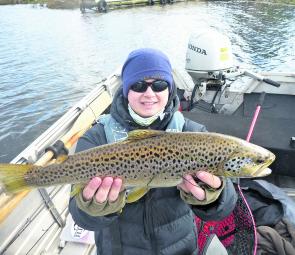November is here and the weather is looking good. Regular flows have been constant in the Derwent, following on from continued doses of very cold water from the highlands with every storage spilling from rain and snow melt.
It’s a good chance to look back and see just what affect this had on the fishery. There was plenty of food around for the trout with good numbers of baitfish. August saw lots of larger bait in their diets along with plenty of eels of varying sizes.
Whitebait schools were showing at the start of September, despite the water temperature. At times they were spread across the river rather than hard up against the banks, with the tell-tale signs on calmer days.
The trout were also in good numbers. Probably not as many as last season, but they were in incredible condition and very good average size; some fish went over the 3kg mark at 60cm in length.
I would like to think that given the cooler than usual water temperatures, we might see the better fish feature a little longer than they have in previous years. Traditionally November would see the trout start to thin out quickly, aside from the scores of barely legal size fish that invade the mid reaches each and every year. It’s a very healthy sign but they can become a little annoying at times trying to wade through them for the better fish.
Last season it was possible to target a Derwent trout over the entire 12 months. I haven’t seen this before but it’s something I hope can continue.
One of the reasons I guess we tend to ‘forget’ about the trout are the very impressive Derwent black bream. We all know how solid our local fish are and it’s certainly no secret around Australia these days. The bream are now pushing upstream readying for the spawning season over the Christmas period. They can be found in excellent numbers right up to and around New Norfolk.
It should be noted that bream are spawning and, given they are schooling and are very readily caught, they are on the ‘do not consume’ list of species in the Derwent. This is due to unhealthy past practises of the modern world through the 70s and 80s in particular. The Derwent is improving markedly and is today a very clean waterway. Unfortunately the sediment on the bottom of the river will not turn over so quickly, hence why the bream and shellfish warnings are in place. It goes without saying Derwent River bream should be returned to the water. The specimens I’ve eaten from the east coast showed they are far from a good table fish anyway but I’ve no qualms in anyone keeping a few fish for a feed.
Our local tributaries will be starting to offer a little life for the fly angler in particular. Lower water levels and steady flows all pointing to good insect life. Not only the majors like the Tyenna and Styx rivers, but right in Hobart streams, such as New Town Rivulet, offer some ultra-light sport not far from many people’s front doors.
Lake Pedder also offering the first signs of mudeye hatches as we move toward December. The enormous midge fishery is also hotting up. In the right conditions these rising fish can last right through the morning just like the wind-lanes that can stretch on for hours. While I really enjoy the hot summer months out here it can be an exciting time if you hit the right day with the fly. Regardless, Pedder is a very reliable lure fishery any day of the year.
Reads: 2058
Isaac Harris with a beautifully marked Derwent brown.

Justin and Max Rigby of Team Rig fishing the open expanses south of the Bridgewater Bridge.

Leigh McKenzie of Bream and Trout Fishing Tasmania with another very good Derwent trout.




